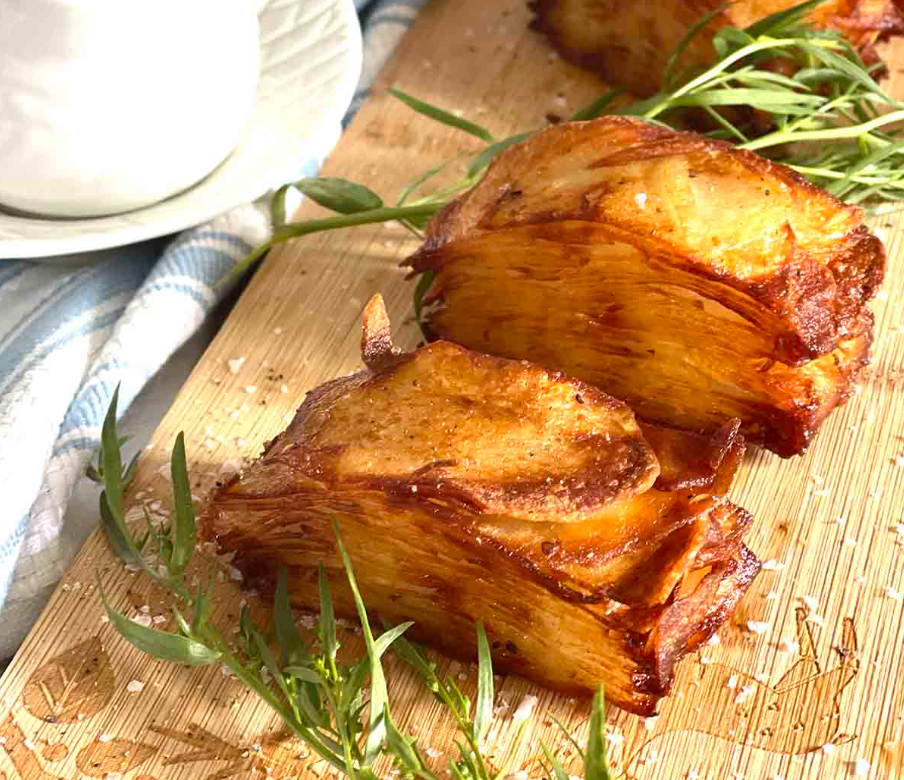Introduction to Confit Potatoes
Confit potatoes, a culinary gem with deep historical roots, have emerged as a beloved dish in both traditional and modern kitchens. The term “confit” originates from the French word confire, which means “to preserve.” This cooking technique, initially used for preserving meats in fat, has been adapted over centuries to include vegetables, particularly potatoes.
The essence of confit potatoes lies in their preparation method. Potatoes are slowly cooked in fat, typically duck or olive oil, at low temperatures. This process not only preserves the potatoes but also imparts a rich, creamy texture and deep, nuanced flavors that are hard to achieve through other cooking methods.
Over time, confit potatoes have gained immense popularity due to their versatility and luxurious taste. They can be served as a sophisticated side dish, complementing a wide range of main courses from elegant dinner parties to casual family meals. Their ability to absorb and enhance the flavors of accompanying herbs and spices makes them a favorite among chefs and home cooks alike. This versatility, combined with their delicious taste, has cemented confit potatoes as a staple in the culinary world.
The Art of Making Confit Potatoes
The traditional method of preparing confit potatoes involves slow-cooking potatoes in fat, a technique that dates back to ancient times for preserving food. The process is simple yet requires attention to detail to achieve that perfect blend of texture and flavor.
Selecting the Right Potatoes
Selecting the right potatoes is crucial for creating the perfect confit. The ideal candidates are waxy varieties such as Yukon Gold, fingerlings, or red bliss. These types are preferred for their lower starch content and firmer texture, which helps them maintain their shape and integrity during the slow cooking process. Unlike starchy potatoes like Russets, which tend to become mushy and break apart, waxy potatoes absorb flavors beautifully while retaining a pleasant, creamy texture. The choice of potato not only affects the dish’s texture but also its overall flavor, making the selection process a key step in the art of making confit potatoes.
The Role of Fat in Confit Cooking
The role of fat in confit cooking is pivotal, acting as more than just a cooking medium. It imparts rich, deep flavors and a luxurious texture to the potatoes. Traditionally, duck fat is used for its unique taste and high smoke point, making it ideal for the low and slow cooking process. Alternatively, olive oil offers a lighter but equally flavorful option. The fat envelops the potatoes, ensuring they cook evenly while infusing them with a subtle, savory essence. This method of cooking in fat, as seen in traditional French cuisine, elevates simple ingredients to a gourmet level, showcasing the transformative power of fat in confit cooking.
Cooking Process and Temperature Control
The cooking process and temperature control are critical in confit cooking, requiring precision and patience. Confit potatoes are typically cooked at a low temperature, ranging from 200°F to 275°F (93°C to 135°C). This gentle approach allows the potatoes to cook evenly, becoming tender without falling apart. The low heat ensures that the flavors from the fat and any added herbs are absorbed slowly, resulting in a rich and nuanced taste. Maintaining a consistent temperature is key to achieving the desired creamy texture and depth of flavor. For more insights on perfecting this technique, Simply Recipes offers a comprehensive guide on mastering the art of low-temperature cooking.
Flavor Infusion with Herbs and Spices
Flavor infusion is a cornerstone of confit cooking, with herbs and spices playing a vital role in elevating the dish. As the potatoes slowly cook in fat, they absorb the aromatic essences of added herbs like rosemary, thyme, or bay leaves, and spices such as garlic or peppercorns. This infusion process imparts a depth of flavor that is both subtle and complex. The choice of herbs and spices can vary, allowing for personalization and experimentation. Each combination creates a unique flavor profile, transforming the confit potatoes into a culinary delight that beautifully complements a variety of main courses with its rich and aromatic character.
Variations of Confit Potatoes
Different Types of Potatoes Suitable for Confit
When selecting potatoes for confit, the variety plays a significant role in the outcome of the dish. Waxy potatoes are the most suitable due to their low starch content and firm texture. Varieties like Yukon Gold, fingerlings, and red bliss are excellent choices, as they maintain their shape and offer a creamy texture after cooking. These types absorb the flavors of the fat and herbs well, without becoming mushy. Avoid high-starch potatoes like Russets, which can break down and lose their structure during the slow cooking process. Each variety of waxy potato brings its unique taste and texture, adding a distinct character to the confit.
Alternative Fats for Confit
In confit cooking, the fat you choose plays a crucial role in determining the dish’s flavor and texture. Chefs often prefer duck fat for its rich, savory taste and its ability to handle low and slow cooking temperatures well. Duck fat brings an unmatched depth of flavor, making it a top choice for classic confit. On the other hand, olive oil offers a versatile and lighter alternative, delivering a subtly different yet equally delightful flavor profile. It’s especially appealing for those seeking a vegetarian option, ensuring that the luxurious texture and taste of confit cooking remain uncompromised. Both fats guarantee tender, flavorful, and perfectly cooked potatoes.
Innovative Twists and Flavor Combinations
Confit potatoes, while traditional in their preparation, offer a canvas for innovative twists and flavor combinations. Chefs and home cooks alike can experiment by infusing different herbs and spices into the fat. For instance, adding a sprig of lavender or a hint of smoked paprika can introduce an unexpected yet delightful flavor. Incorporating citrus zest or a dash of truffle oil towards the end of cooking can elevate the dish to a new level of sophistication. These creative variations not only enhance the taste but also bring a personalized touch to the classic confit, making each batch unique and tailored to individual palates.
Serving and Pairing Ideas
Meat and Vegetarian Dishes
Confit potatoes, with their rich and creamy texture, make an ideal accompaniment for both meat and vegetarian dishes. For meat lovers, they pair beautifully with roasted or grilled meats, such as steak, lamb, or duck, where their subtle flavors complement the savoriness of the meat. In vegetarian cuisine, confit potatoes add depth and heartiness to dishes. They work splendidly alongside grilled vegetables, in a salad with fresh greens, or as a base for a flavorful vegetable stew. Their versatility and luxurious taste make confit potatoes a perfect side dish, enhancing the overall dining experience with their unique and sumptuous flavor profile.
Creative Serving Suggestions
Confit potatoes offer a playground for creative serving suggestions. One elegant idea is to present them as a potato stack, layering thinly sliced confit potatoes and baking them until they form a crispy, golden tower. Another innovative approach is to gently smash the potatoes after confiting, then quickly pan-fry for a crispy exterior and a soft, creamy center. For a more rustic presentation, mix whole confit potatoes with fresh herbs and a sprinkle of coarse sea salt, serving them family-style. These versatile potatoes can also be diced and added to a warm potato salad, offering a luxurious twist to a classic dish.
Transforming Leftovers
Leftover confit potatoes can be ingeniously transformed into new, delightful dishes. One option is to chop them into smaller pieces and incorporate them into a hearty breakfast hash, mixed with onions, peppers, and topped with a fried egg. They also make an excellent base for a potato soup, blended with stock and cream for a rich and comforting meal. For a light lunch, slice the potatoes and layer them in a savory tart or quiche, adding depth with their creamy texture. These versatile leftovers can even be mashed and used as a flavorful filling for potato croquettes or as a topping for shepherd’s pie.
Nutritional Profile and Dietary Considerations
Confit potatoes are a culinary delight but have high caloric content. This is due to the fat used in the confit process, like duck fat or olive oil. These fats add rich flavors and increase the dish’s fat and calorie count. However, they also offer nutritional benefits. For example, olive oil contains heart-healthy monounsaturated fats.
It’s important to enjoy confit potatoes in moderation. This is especially true for those watching their calorie intake or managing conditions like heart disease or obesity. Portion control helps balance indulgence and health.
You can adapt confit potatoes for different diets. For vegetarians or vegans, high-quality plant-based oils like olive or avocado oil are great substitutes for animal fats. To reduce fat content, try a mix of oil and flavorful vegetable broth. This might slightly alter the traditional texture and taste but creates a healthier variation.
In summary, confit potatoes are a luxurious treat. But being mindful of their nutritional profile and adapting the recipe can make them suitable for various diets.
FAQs on Confit Potatoes
Q: What are the best potatoes for confit?
A: Waxy varieties like Yukon Gold, fingerlings, or red bliss are ideal for confit. They hold their shape well and absorb flavors effectively without becoming mushy.
Q: Can I use other fats besides duck fat or olive oil for confit?
A: Yes, you can experiment with other fats like goose fat, butter, or high-quality vegetable oils. Each fat will impart a different flavor profile to the potatoes.
Q: How long should I cook confit potatoes?
A: You should cook confit potatoes at a low temperature (200°F to 275°F) for 2-3 hours. The goal is to achieve tender potatoes that are not falling apart.
Q: Can I make confit potatoes in advance?
A: Yes, you can definitely prepare confit potatoes in advance. This makes them a convenient option for meal planning. Just store them in the refrigerator for up to 5 days and reheat when needed.
Q: Are confit potatoes suitable for a gluten-free diet?
A: Absolutely, confit potatoes are naturally gluten-free, making them a great choice for those following a gluten-free diet.
Q: Is it okay to freeze confit potatoes?
A: You can freeze confit potatoes, but I wouldn’t recommend it. Freezing can change their texture. They are best enjoyed fresh or stored in the refrigerator.
Q: How can I make confit potatoes healthier?
A: To make them healthier, consider using olive oil, which is high in monounsaturated fats, and be mindful of portion sizes. You can also add herbs and spices for flavor without extra calories.
Tips and Tricks for Perfect Confit Potatoes
- Start with Quality Ingredients: The quality of potatoes and fat significantly affects the final dish.
- Temperature Control: Maintain a consistent low temperature for even cooking.
- Experiment with Flavors: Don’t be afraid to try different herbs and spices.
In conclusion, confit potatoes offer a delightful culinary experience, rich in history and flavor. Whether you’re a seasoned chef or a home cook, this dish provides ample opportunity for creativity and experimentation. For more inspiration, check out Kitchen Flavors’ guide to potato tacos, which can be a great accompaniment to confit potatoes. Enjoy the journey of making this exquisite dish and savor every bite!




